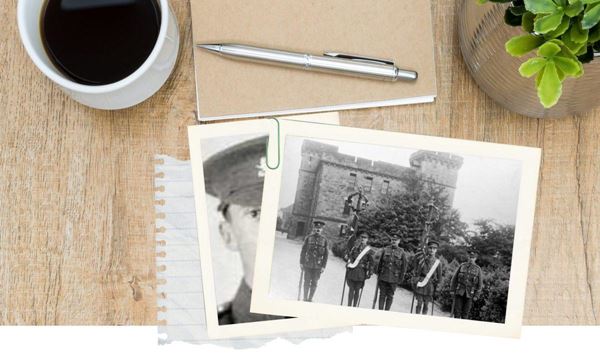Regimental Research Enquiries
The King’s Own Museum receives a high number of research enquiries and is happy to provide a service to assist you in your research. However, there is a charge to cover our costs.
Please note we ONLY have information on Lancaster's King's Own Royal Regiment, which existed from 1680 to 1959.
- After this it was merged with the Border Regiment to form the new King's Own Royal Border Regiment, which existed from 1959 to 2006. We do have some photos of this regiment here, but if the Royal Border Regiment is the subject of your enquiry, please contact the researchers at Cumbria's Museum of Military Life instead of our team.
- Another merge in 2006 created the Duke of Lancaster's Regiment. Information about this is available on the Duke of Lancaster's Regimental Association website.

For staff time undertaking research:
- Minimum charge £10, to be paid in advance.
- £10 per half hour after that.
The advance payment of £10 covers half an hour of work on your enquiry. After this we will contact you with an estimated price for any further research before we continue.
If you require paper copies of any documents, photocopying charges are as follows:
- A4 - 30p per page
- A3 - 70p per page
Scans of photos or documents:
- 10p per page (dependent upon copyright restrictions)
General advice on how you can conduct your own research (some of it for free) is provided at the end of this page.
Please note that we do not hold records or information on every soldier who served with the King’s Own. The information below provides guidance on what we are able to do and what we cannot do.
What we can do:

- Conduct research into soldiers who served with the King’s Own Royal Lancaster Regiment (and its antecedent Regiments of Foot – details of these can be found at the ‘Regimental History’ section at www.kingsownmuseum.com).
- Check our archives to see if we are holding any documents relating to the soldier that you are enquiring about. This includes, letters, diaries, pay books and other paper items that have been donated to the museum over the years.
- Check the limited volumes of the ‘Army List’ that we hold for officers
- Check the AB358 volumes for soldiers who served during the 1920s through to the early 1940s (please note that these hold very limited information, particularly the later ones)
- Undertake online research on your behalf for King’s Own soldiers who served before 1921 (note that the information at the foot of this page explains how you can do this yourself, some of it for free). Examples of online research includes checking the Commonwealth War Graves Commission website and genealogy websites such as Ancestry and Find My Past.
- Search the regimental history and any relevant War Diaries that we have access to. Please note that most soldiers who served with the King’s Own won’t be mentioned in these documents, but if you have provided information to identify which battalion they served in and the relevant dates, we should be able to provide details of where that battalion was and what duties or actions they were engage in at that time.
What we cannot do:

- Please note that if the person you are enquiring about was a soldier of the rank of private serving in either World War I or World War II, it is unlikely we will hold any information, and if we do then it will probably be very limited. This is due to the records for privates in the First World War being destroyed and records for privates serving during the Second World War being transferred to the National Archive by the MOD.
- We cannot conduct research into soldiers who served in regiments (or corps) other than the King’s Own Royal Lancaster Regiment. For these you will need to contact the relevant regimental museum. Details of other regimental museums can be found at: Army Museums Ogilby Trust
- We cannot obtain records for soldiers who served after 1920. These are still held by the Ministry of Defence; you can make an online application to see them via GOV.UK.
- We cannot provide photographs of individual soldiers. Whilst our archives contain many photographs, not all soldiers were photographed and many of the photographs that we hold do not have a record of the name of the soldier(s) in them.
We aim to complete research within 12 weeks. Often this will take significantly less time and occasionally, due to complexity, it may take longer. As we have limited staff research time available, at busy times, we might also have a backlog of enquiries, which can also impact timescales. Enquiries will be dealt with strictly in order of receipt.
Please note that there may be times when we have searched for the information requested, but have been unable to find anything either in our archives or online. As staff time will have been expended on this, payment will still be due.
If you would like us to undertake research for you, click here to complete our Email Enquiry Form.
- Please note that the minimum charge of £10 must be paid before any research is carried out. Payment can be made online or by phone. We'll contact you to arrange this after we receive your enquiry.
- It's important that you also provide us with as much information as you can on the subject of your enquiry, as this will greatly assist us when undertaking the research for you. Please fill in as much as possible of the information listed on the form. Military details such as regiment, rank and army number can be found on discharge documents or on the edge or back of some medals (usually WWI or earlier, WWII campaign medals do not have the soldier’s details on them).
- Please be aware that the museum does not have a full-time team to respond to enquiries on a regular basis. It may take a while for us to get back to you, but we will do so as quickly as possible.
When doing military genealogy, it's useful to have as much information as possible on the soldier before you start to use as a cross reference to make sure that you have the right person’s record (see list above). For example, there were thousands of soldiers called John Smith who served and even a name that seems unusual can produce several possible results considering that around 9 million people served in the British armed forces during WWI.
Here are some links and details on places where you might be able to obtain additional information:
King's Own Royal Regiment History site - Includes a complete history of the regiment and the stories of many of its soldiers. The site has thousands of photos and a huge amount of information on the objects and archives in the museum's collections.
Ancestry.co.uk – Holds digitised records of British soldiers held at the National Archives. This is useful for researching soldiers who served prior to 1921 and in particular during the First World War. Whilst it is a subscription site, many local libraries have licences and research can be done for free on the library’s public computers with guidance from the library staff. Records that are available on this site include:
- Medal index cards If an ancestor served in a ‘Theatre of War’ during WWI, there is a very high probability that there will be a medal index card for that soldier.
- Medal Rolls If an ancestor served in a ‘Theatre of War’ during WWI, there is a very high probability that there will be a medal roll entry for that soldier.
- Service Records If an ancestor served during WWI, there is approximately a 1 in 3 chance that there will be a surviving Service Record for that soldier. Many records were destroyed during the Blitz in WWII. Service Records can include a huge amount of information including, date joined, description of the soldier, next of kin details, military medical history, postings, transfers, promotions, disciplinary action, military courses attended and medals awarded.
- In addition to the above, there are other record sets available on the site and more are being added all the time. There is also the facility for relatives to upload photographs of people, letters and documents held by them, so sometimes family researchers might find that a distant cousin has added items held by them to the site.
Find My Past – like ‘Ancestry’ this is a genealogy site which has digitised records of British soldiers held at the National Archives. This is useful for researching soldiers who served prior to 1921 and in particular during Victorian times and the Boer War. Whilst it is a subscription site, many local libraries have licences and research can be done for free on the library’s public computers with guidance from the library staff.
Commonwealth War Graves Commission (CWGC) – The CWGC website is free to use and has records of where all British soldiers who died during WWI or WWII and who are either buried or commemorated in a CWGC cemetery. Information available here includes name, rank, number, regiment, location details and photographs of the cemetery, a downloadable PDF certificate, and can include next of kin, home address and headstone information including the words that the next of kin chose to be added.
Lives of the First World War – This website is free to use and was set up by the Imperial War Museum (IWM) during the WWI Centenary as a memorial to all those who took part in any capacity. There are limited details from official records, but this does include transcripts of the information on the WWI Medal Index Cards, so every soldier who served in a ‘Theatre of War’ during WWI should have an entry on the site. There was also the facility for relatives to upload photographs of people, letters and documents, family memories or anecdotes held by them, so sometimes family researchers might find that a distant cousin has added items held by them to the site. IWM stopped adding to the website at the end of the WWI Centenary period.
National Archives – The National Archives in London holds the original documents that genealogy sites like Ancestry and Find My Past have digitised. However, they also have certain record sets that can be downloaded and viewed for a modest fee. Most useful for the military genealogist are Battalion War diaries. If you know which Battalion an ancestor served with and when, you could get a good idea of what they were doing and where by reading the Battalion War Diary. During WWI, a Battalion consisted of around 1,000 soldiers. Commissioned Officers are mentioned by name, Other Ranks are not usually mentioned by name.
Soldiers who served after 1920 – There are a few digitised documents mentioning soldiers who served after 1920 online, however, most of their records, including those who served during WWII, are still currently held by the Ministry of Defence (MOD). There is information available on the GOV.UK website providing information about how people can apply for the information from Service Records. The MOD charge a fee for this service. Over time more records will be released from the MOD to the National Archives and they are likely to be digitised in due course.


